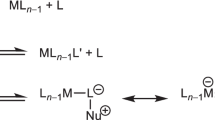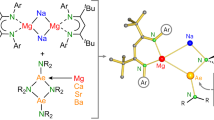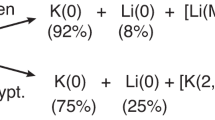Abstract
ACETYLACETONE (acacH), from which the unknown chelate, dithioacetylacetone, can theoretically be obtained by substitution of two oxygen atoms with sulphur, is one of the most versatile bidentate chelates known1. In the enol form the hydroxylic proton can readily be replaced by a great many metal ions to give neutral complexes of the composition M(acac)n. The co-ordination number of the metal is usually 2n and the resulting stereochemistry is tetrahedral, square planar or octahedral, although examples of square antiprismatic and square pyramidal co-ordination are known. The bonding to the metal is invariably through the two oxygen atoms, although it has been shown2 recently that the α-carbon atom can bond to platinum in the compound trimethyl (acetylacetonyl)-2 : 2′ bipyridyl platinum (IV). Certain of the metal acetylacetonates undergo reactions characteristic of aromatic systems and these have been reviewed by Prof. Collman3.
This is a preview of subscription content, access via your institution
Access options
Subscribe to this journal
Receive 51 print issues and online access
$199.00 per year
only $3.90 per issue
Buy this article
- Purchase on Springer Link
- Instant access to full article PDF
Prices may be subject to local taxes which are calculated during checkout
Similar content being viewed by others
References
Harris, C. M., and Livingstone, S. E., in Chelating Agents and Metal Chelates, edit. by Dwyer, F. P., and Mellor, D. P., 100 (Academic Press, New York, 1964).
Swallow, A. G., and Truter, Mary R., Proc. Roy. Soc., A 266, 527 (1962).
Collman, J. P., Angew Chem. (Internat. Ed.), 4, 132 (1965).
Ewald, A. H., Martin, R. L., Ross, I. G., and White, A. H., Proc. Roy. Soc., A, 280, 235 (1964).
Fromm, E., and Ziersch, P., Chem. Ber., 39, 3599 (1906).
Fredga, A., and Brandstrom, A., Arkiv Kemi, Mineral. Geol., 26B, No. 4 (1948).
Fredga, A., and Brandstrom, A., Arkiv Kemi, 1, 197 (1949).
Martin, R. L., Porter, Q. N., and Stewart, I. M. (unpublished results).
Chaston, S. H. H., and Livingstone, S. E., Proc. Chem. Soc., 111 (1964).
Chaston, S. H. H., Livingstone, S. E., Lockyer, T. N., Pickles, V. A., and Shannon, J. S., Austral. J. Chem., 18, 673 (1965).
Gray, H. B., and Ballhausen, C. J., J. Amer. Chem. Soc., 85, 260 (1963).
Hoskins, B. F. (unpublished results).
Author information
Authors and Affiliations
Rights and permissions
About this article
Cite this article
MARTIN, R., STEWART, I. Synthesis of Transition Metal Complexes of the Unknown Chelate, Dithioacetylacetone. Nature 210, 522–523 (1966). https://doi.org/10.1038/210522a0
Issue Date:
DOI: https://doi.org/10.1038/210522a0
Comments
By submitting a comment you agree to abide by our Terms and Community Guidelines. If you find something abusive or that does not comply with our terms or guidelines please flag it as inappropriate.



